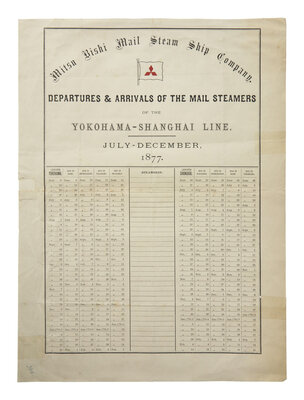[Business & Industry] Mitsu Bishi Mail Steam Ship Company Broadside. Rare Printed Broadside
Sale 2107 - Collections of an Only Child: Seventy Years a Bibliophile, the Library of Justin G. Schiller
Dec 5, 2024
10:00AM ET
Live / New York
Estimate
$500 -
800
Lot Description
[Business & Industry] Mitsu Bishi Mail Steam Ship Company Broadside
(Yokohama, Japan), 1877. Printed broadside, 16 1/4 x 12 in. (mm). Timetable listing service on the Mitsu Bishi Mail Steam Ship Line between Yokohama and Shanghai from July-December, 1877. Creasing from old folds, a few marginal tears repaired with cello-tape on verso, paper loss to left margin repaired, scattered light foxing.
Scarce broadside relating to the origins of the Mitsubishi Corporation and the birth of modern industrial Japan, printing the service schedule of its flagship shipping route--with one of the earliest examples of its iconic three-diamond logo.
The Mitsubishi Steamship Company operated Japan's first passenger line service, as well as its first overseas shipping route, between Yokohama and Shanghai, beginning on February 3, 1875. Founded in 1870 by Iwasaki Yataro as the Tsukumo Shokai shipping firm, it grew at an incredible pace, changing names in 1872 to Mitsukawa Shokai, and in 1874 to Mitsubishi Shokai. In 1885 it merged with Kyodo Unyu Kaisha, becoming Nippon Yusen Kabushiki Kaisha (Japan Mail Steamship Company), as it is known today. Mitsubishi's rapid growth reflected its astute business practices, its diversification into related fields of production including coal mining, warehousing, shipbuilding, insurance, and banking, as well its symbiotic relationship with the Meiji government. By 1880 Mitsubishi was the largest shipping company based in East Asia, and by the turn of the century it operated one of the largest shipping lines in the world.
This rare broadside reflects an important moment in the company's history, depicting the service schedule of its flagship route, at moment when it was attaining regional dominance, and helping solidify Japan's economic revolution in the second half of the 19th-century.
This lot is located in Philadelphia.
Provenance
From the collection of Justin G. Schiller
Condition Report
Contact Information

